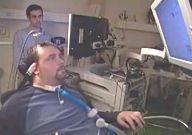
A sensor implanted in a paralysed man's brain has enabled him to control objects by using his thoughts alone. The experimental set-up allowed the man, who has no limb movement at all, to open e-mail, play a computer game, and pinch a prosthetic hand's fingers. The US team behind the sensor hopes its technology can one day be incorporated into the body to restore the movement of paralysed limbs themselves. The Massachusetts-based team's study is published in the journal Nature. Matthew Nagle, 25 at the time of the trial, was left paralysed from the neck down and confined to a wheelchair after a knife attack in 2001. He was the first patient to try out the brain sensor. A team of scientists inserted the device, called a neuromotor prosthesis (NMP), into an area of the brain known as the motor cortex, which is responsible for voluntary movement. The NMP comprises an internal sensor that detects brain cell activity, and external processors that convert the activity into signals that can be recognised by a computer.
Although the patient's spinal cord had been severed for three years by the time of the trial, the scientists found that brain cell activity - or neural firing patterns - persisted in the patient's motor cortex. The electrodes in the NMP were able to record this activity and send it to a computer. The computer then translated the firing patterns into movement commands which could drive computer controls or artificial limbs.
